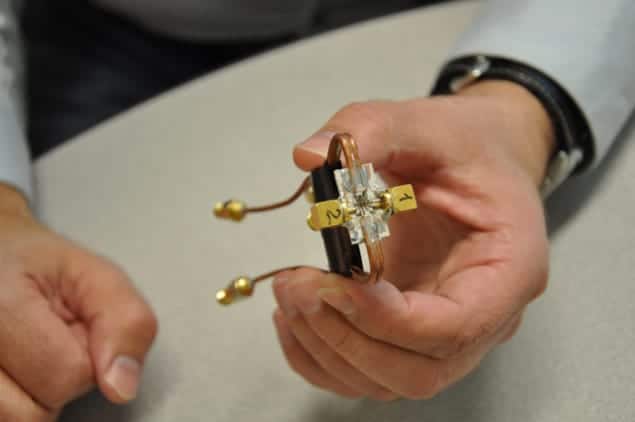
A new type of memory device based on the interference of spin waves has been unveiled by scientists in the US and Russia. Data are stored in the form of magnetic bits and read out simultaneously as holographic images. Because the wavelengths of the spin waves are much shorter than those of light, the storage density of the memory has the potential to be much greater than systems based on optical holograms, and could someday be used to store very large amounts of information.
Conventional holography involves splitting a beam of laser light into an illumination beam and a reference beam. The illumination beam is fired at the object of interest and the deflected light is sent to a detector (or photographic film), where it is reunited with the reference beam. The detector records the interference between the two beams and this information is then used to create a 3D image of the object. As well as being used as a security feature on credit cards and banknotes, holograms also have the potential to store and retrieve large amounts of information in a very efficient way.
However, the storage densities that can be achieved using optical holograms are limited by the relatively long wavelengths of visible light – about 500 nm. Now, Alexander Khitun and colleagues at the University of California, Riverside and the Kotel’nikov Institute of Radioengineering and Electronics in Saratov, Russia, have created a holographic memory that uses spin waves, which have much shorter wavelengths.
X and Y orientations
The team’s prototype device comprises two small magnets – each about 360 μm wide – that are connected by a magnetic wire. Data are stored in the device in terms of the orientations of magnetic moments of the magnets. For example, the “00” state corresponds to both magnets being oriented along the x-axis and “01” corresponds to the first magnet being oriented along x-axis and the second along the y-axis.
As well as being connected to each other, each magnet also has three other magnetic wires connected to it for the purposes of inputting and outputting spin waves. The waves are created by applying an electrical signal to tiny antennas connected to the wires, and the antennas also act as spin-wave detectors.
Data are written to the device using spin waves with relatively large amplitudes that are capable of changing the orientation of the magnet bits.
The read process involves sending spin waves with smaller amplitudes through the device, where the phases of the waves are affected by the orientations of the two bits. The antennas are then used to measure the interference between the waves. By varying the relative phases of the input spin waves, the team can build up a holographic image of the orientation of the two magnets. This is analogous to how an optical holographic image is built up by varying the angle between the object and the illumination beam.
Simultaneous access to data
While creating a device based on two magnetic bits might not seem like a major breakthrough, the holographic nature of the technique means that it could be used to read and write huge numbers of data simultaneously to and from large arrays of magnetic bits. This is unlike hard-disk drives (HDDs), which read and write data sequentially from magnetic bits. What is more, because the wavelength of the spin waves is about 10 nm, devices with storage densities comparable to the best HDDs could be built – at least in principle.
The team’s first prototype uses relatively large wires and magnets, but Khitun told physicsworld.com that the team has already built a working prototype where the magnets have been shrunk to 12 μm. Furthermore, he says that numerical simulations suggest that reliable devices could be made with feature sizes as small as 10 nm. Khitun and colleagues are also working on a memory device based on a 4 × 4 matrix of 16 magnetic bits, which they plan to demonstrate later this year.
The memory is described on the arXiv preprint server.
- The principles of optical holographic data storage are described in this feature-length article by scientists at the IBM Almaden Research Center: “Optical data storage enters a new dimension”



